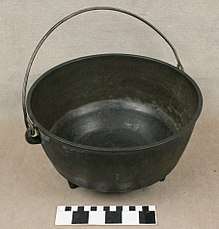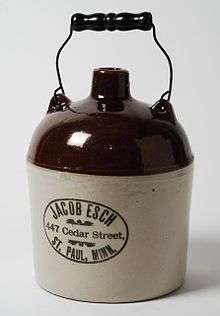Bail handle
A bail handle, or simply bail, is a handle that consists of an open loop that moves freely within two fixed mounts or ears. Several designs are available: bails are typically made of metal (wire) or plastic.[1][2][3][4] It is a type of package handle which may be used for carrying an item, such as a tin can or bucket; or kettle, or as a drawer pull. A bail handle can also be used to hang an item such as a pharmaceutical bottle[5][6] potted plants, etc.

A flip-top closure on a bottle or jar is sometimes called a bail closure.
Decorative bail handles appeared on pieces of French Rococo furniture during the early 18th century. These handles on drawers were rounded and hinged onto an escutcheon plate and hung down in the shape of a half moon or arch. Due to being hinged, they were able to move up and down and they were usually elaborately decorated.[7]
Examples
- Plastic yellow pail or bucket

.jpg) Paint can with bail handle
Paint can with bail handle Pails with handles being reused
Pails with handles being reused Plastic handle (hanger) for glass IV bottle
Plastic handle (hanger) for glass IV bottle- Footlocker with bail-style wire Latch
References
- US5457850A, Knox, "Plastic bail handle", published 1992
- US3481501A, Anderson, "Plastic container having integral molded bail handle", published 1969
- US1730820A, Holden, "Bail Handle", published 1929
- US3093257A, Charles, "Bail arrangement", published 1963
- US4269322A, Larson, "Flexible bail assembly", published 1980
- US4396128A, Larson, Johnson, "Bail Structure", published 1983
- "Bail Handles", White Chapel LTD, retrieved November 12, 2012
Books
- Yam, K.L., "Encyclopedia of Packaging Technology", John Wiley & Sons, 2009, ISBN 978-0-470-08704-6
- Soroka, W, "Fundamentals of Packaging Technology", IoPP, 2002, ISBN 1-930268-25-4